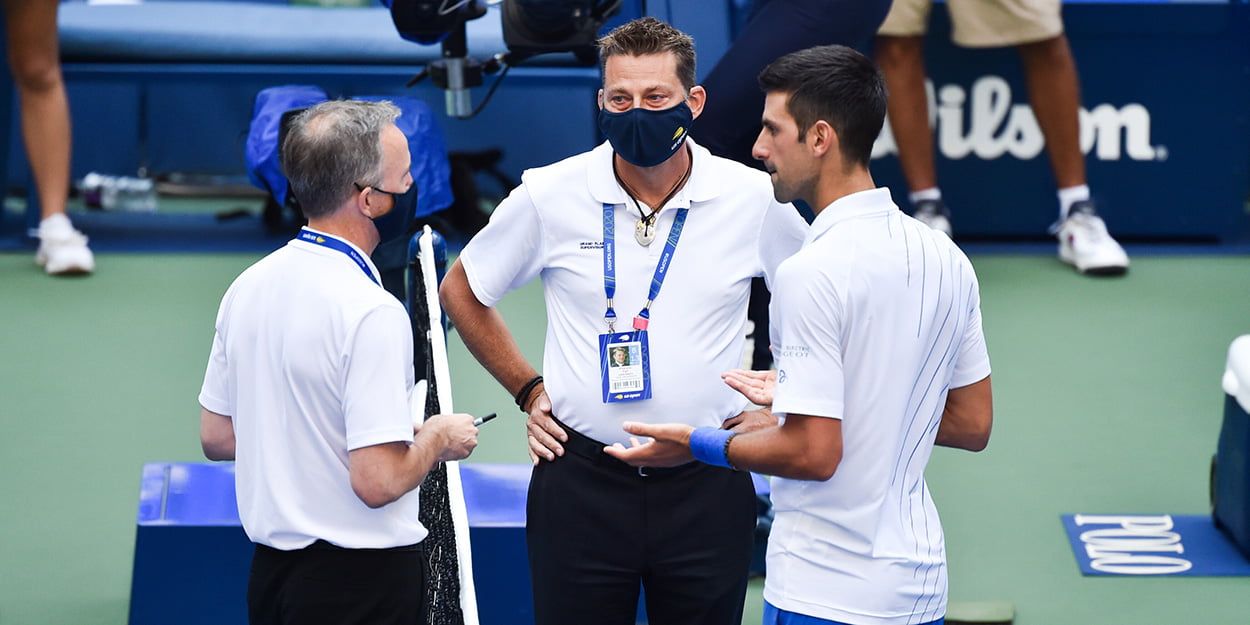
Novak Djokovic states there is “no reason to keep line umpires” as we investigate the court of the future
Look carefully at the next photograph from the 2020 US Open and you will see that something is missing: the match is being played without line judges. The use of Hawk-Eye Live at a Grand Slam tournament for the first time could be the shape of things to come, especially if Novak Djokovic has his way.
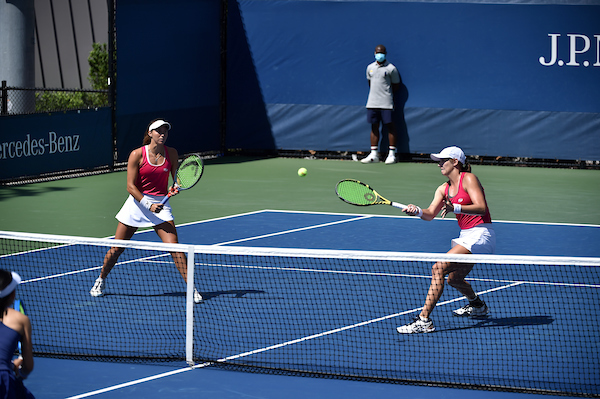
A US Open 2020 match with Hawk-Eye Live instead line judges
The US Open prides itself on being a trail-blazer. It was the first Grand Slam event to offer equal prize money to men and women, the first to introduce tie-breaks and the first to stage night sessions. Flushing Meadows was also the first to embrace Hawk-Eye line-calling technology, in 2006, and took it a step further at this year’s tournament with the use of Hawk-Eye Live. For the first time at a Grand Slam event, matches were played with no line judges as Hawk-Eye’s computerised cameras made all the line calls.
The only courts where line judges were on duty, with players able to challenge their calls, were in Arthur Ashe Stadium and Louis Armstrong Stadium. Novak Djokovic, for one, might have wished that Hawk-Eye Live had operated on all courts after he was defaulted for hitting a line judge in the throat when he carelessly knocked a ball away in frustration in Arthur Ashe Stadium.
Hawk-Eye Live had been used successfully at both the ATP’s Next Gen Finals in Milan and by World Team Tennis. Over the course of four weeks in New York this summer (the system was also used at the preceding Western & Southern Open, which was moved from Cincinnati) Hawk-Eye Live made more than 300,000 line calls, including nearly 12,000 that were defined as close. “Out” calls boom out from on-court speakers using pre-recorded voices. The system uses 12 cameras on each court to track the flight of the ball as well as six foot-fault cameras. The latter are monitored by an official in the Hawk-Eye booth who presses a button when a foot fault is identified.
“Sometimes if you’re playing on a court where there are other courts next to it you’re not really sure where the call came from”
“It’s been a terrific success, there’s no debate,” Stacey Allaster, the US Open tournament director, said after the tournament when asked about Hawk-Eye Live. “We couldn’t be more pleased with how it has been executed.”
Most players welcomed Hawk-Eye Live and thought it had worked well, though some expressed concern for the hundreds of line officials who were denied work as a consequence. The US Open normally has about 350 line judges on duty, but this year only 74 were called up. The need, for health reasons, to have fewer people on-site was one of the factors behind the decision to use Hawk-Eye Live in New York. Allaster insisted that no decisions had been made about whether to use it at next year’s US Open.
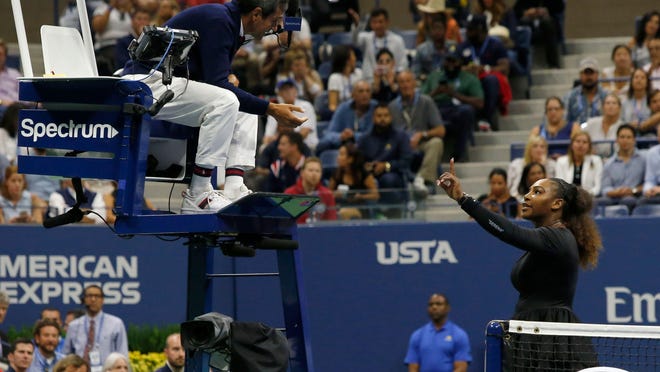
At the 2009 US Open an official was subjected to a profanity-laced tirade from Serena Williams
Bruno Soares, who won the men’s doubles title at Flushing Meadows alongside Mate Pavic, said he was “a big fan” of Hawk-Eye Live. “I would like to see it in all tournaments,” he said. “It just takes away a lot of the doubts, a lot of the problems that we have. I know it takes away some of the drama that fans like to see and arguments and stuff, but I feel that when it’s as accurate as that it leaves the match very clean. You only have to worry about tennis. You don’t have to worry about bad line calls that might interfere with the outcome of the match. I think it’s a huge thing for the sport and it’s great that we’ve used it at a Grand Slam.”
Nevertheless, there were teething problems. At the Western & Southern Open, for example, a Venus Williams serve was called out when it was clearly in. The call was quickly corrected by technicians in the Hawk-Eye booth. On another occasion an “out” call was immediately shown to be wrong by a video replay.
Dominic Thiem said he would “support 100 per cent Hawk-Eye on clay”, while Djokovic could not see why “every single tournament in this world” should not use the system
Sometimes there was confusion caused by the positioning of the speakers broadcasting the “out” calls. “I think there should be speakers on every line,” Soares said. “Sometimes if you’re playing on a court where there are other courts next to it you’re not really sure where the call came from. I played with it once before and they had the speakers on every line, which I thought was much better. At the US Open they had one big speaker at the back of the court. So sometimes you have a call for a shot on the baseline but the call comes from the opposite end of the court. It’s a bit strange. If it’s a close call you don’t know if it’s your court or the court next to you.”
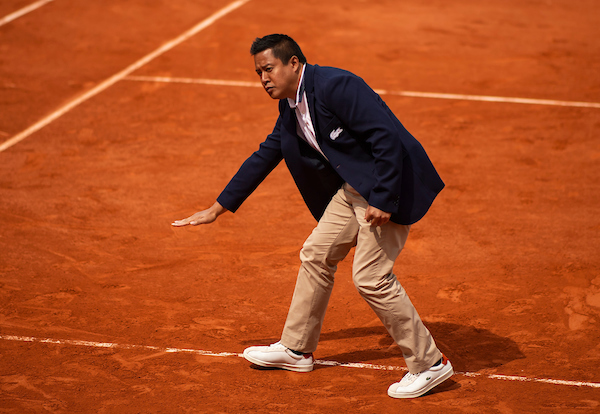
The umpire James Keothavong checks a ball mark at the French Open
That might have been the explanation for a curious incident towards the end of a first-round doubles match on Court 6, where Jack Sock and Jack Withrow won a tight three-set encounter with Dominic Inglot and Aisam-Ul-Haq Qureshi. With the Americans leading 4-2 in the third set tie-break, Withrow hit a big serve, Qureshi made a lobbed return and Sock put away a smash. However, although the serve was clearly in, a call of “out” had boomed out from a speaker. Inglot and Qureshi protested that the point should have been replayed but to no avail.
“We weren’t disputing the serve, we were just saying that the ball was called ‘out’ so you have to replay the point,” Inglot said. “Something similar had happened in Cincinnati in one of the doubles matches and they replayed the point, so this one should have been replayed. It’s a system error, because we weren’t disputing that the serve was in. It was clearly in, but there was obviously some sort of error and they didn’t replay the point. We just thought that wasn’t right.”
The biggest reservation among players was the fate of line judges. Jamie Murray said Hawk-Eye Live was “a great product” but added: “I guess the difficult thing is that if you bring that into tennis you take away pathways and opportunities for linesmen and lineswomen trying to become chair umpires. They would obviously lose a lot of opportunities.”
Murray’s fellow Briton, Cameron Norrie, had similar concerns. “I do feel for a lot of the line judges who do it for a living,” Norrie said. “They love being at the tournaments and travelling. All those people are being cut off. I do like that about the sport and I do know those people love tennis so much. It’s probably tough for them. I think they do a great job. So I’m indifferent really about it. It was good to have Hawk-Eye Live, but I feel sorry for those people.”
However, Norrie agreed that the system had worked successfully. “Everything ran pretty well,” he said. “We had it at the Battle of the Brits too and it was good there. I think it’s a great system. It’s just strange how they did it differently on the two centre courts in New York. I’m not sure why they did that.”
“The ball’s in or it’s out, next point, move on. There’s no faffing around. At times tennis matches are long enough, so if it cuts down on some time I think that’s a good thing.” Jamie Murray
There were no spectators at Flushing Meadows to give their verdict on the system, but some would no doubt have missed the drama that comes when players challenge a line call. Close calls are still shown on a big screen, but there is not the same tension as the outcome of a challenge is awaited.
Murray, however, did not think Hawk-Eye Live detracted from the drama. “The ball’s in or it’s out, next point, move on,” he said. “There’s no faffing around. At times tennis matches are long enough, so if it cuts down on some time I think that’s a good thing.”
While the use of Hawk-Eye Live removes a human element from the show, broadcasters and photographers might be among those who like it. With fewer people around, the court has a much “cleaner” look, while photographers will have fewer occasions to lament the presence of a line judge spoiling their pictures.
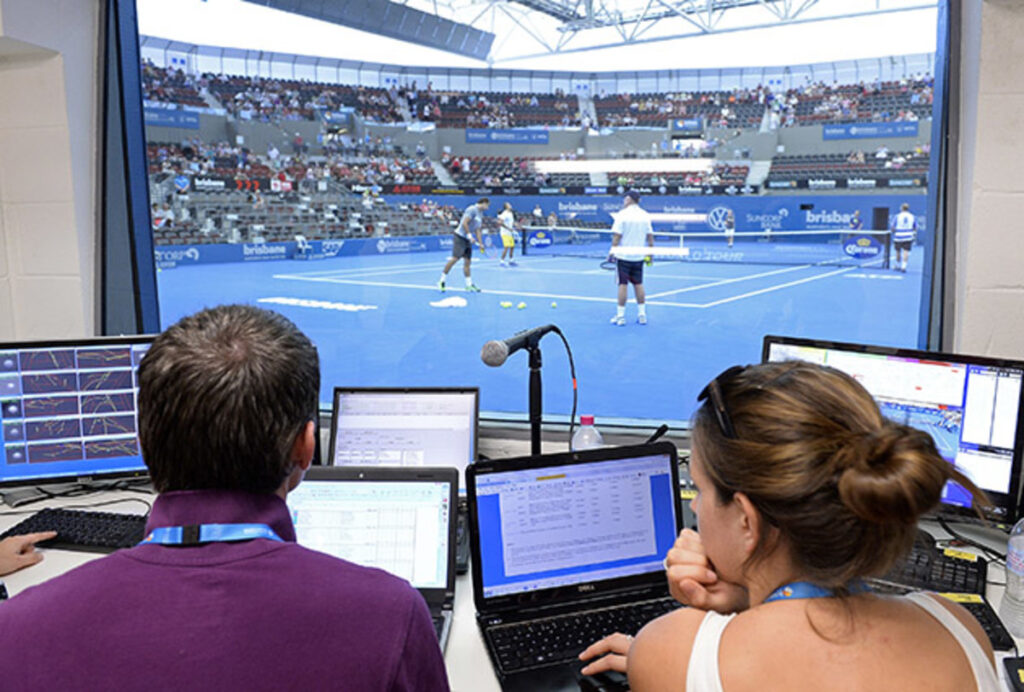
Hawk-Eye officials monitor the system from a courtside-booth
The French Open was a reminder that, for the most part, clay-court tournaments do not use electronic line-calling, with umpires instead checking ball marks when contentious calls are made. However, earlier this year the ATP began an electronic line-calling trial at clay-court events, beginning with the tournament in Rio in February. The jury is still out after the lockdown interrupted the trial, but some players are already convinced.
Dominic Thiem said he would “support 100 per cent Hawk-Eye on clay”, while Djokovic could not see why “every single tournament in this world” should not use the system. “The technology is so advanced right now, there is absolutely no reason why you should keep line umpires on the court,” he said in Paris, before adding with a smile: “Then I would also probably have less chances to do what I did in New York.”
The French tennis federation, however, has no plans to change, and said in a statement to the Reuters news agency that it was “not in favour of replacing umpires with machines”. Nevertheless, for anyone looking for a future career in tennis, the job of line judge might be best avoided.
- Join the tennishead CLUB and receive £250/$350 of FREE GEAR including ASICS Gel-Resolution 8 trainers, shorts, shirt & socks
- Keep up to date with the breaking news & tennis action at our tennis news section
- Win amazing prizes by entering our competitions
- Learn more about your favourite players including Roger Federer, Rafa Nadal and Novak Djokovic
- Check out the latest tennis equipment with our tennis gear reviews
- Receive regular updates in our legendary free newsletter
- Read in depth features with stunning photography in tennishead magazine
- Can’t visit the tournaments you love? Check out our guide on how to watch tennis on TV
- Don’t miss a thing with our Live Scores service
- Follow tennishead on social media at Facebook, Twitter, Instagram & YouTube
- EXCLUSIVE 5% DISCOUNT for all tennishead readers on tennis rackets, balls, clothing, shoes & accessories with All Things Tennis, our dedicated tennis gear partner


